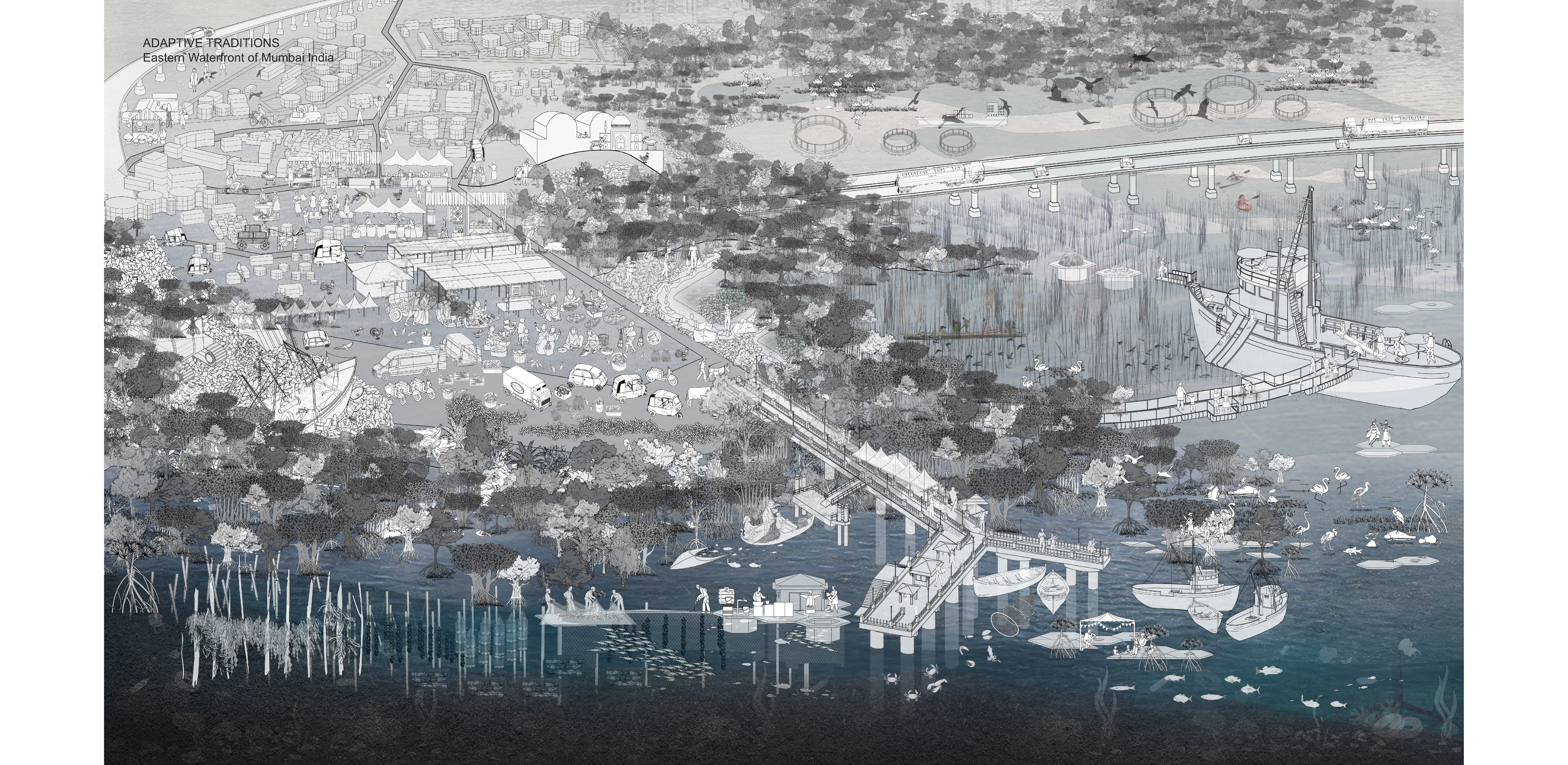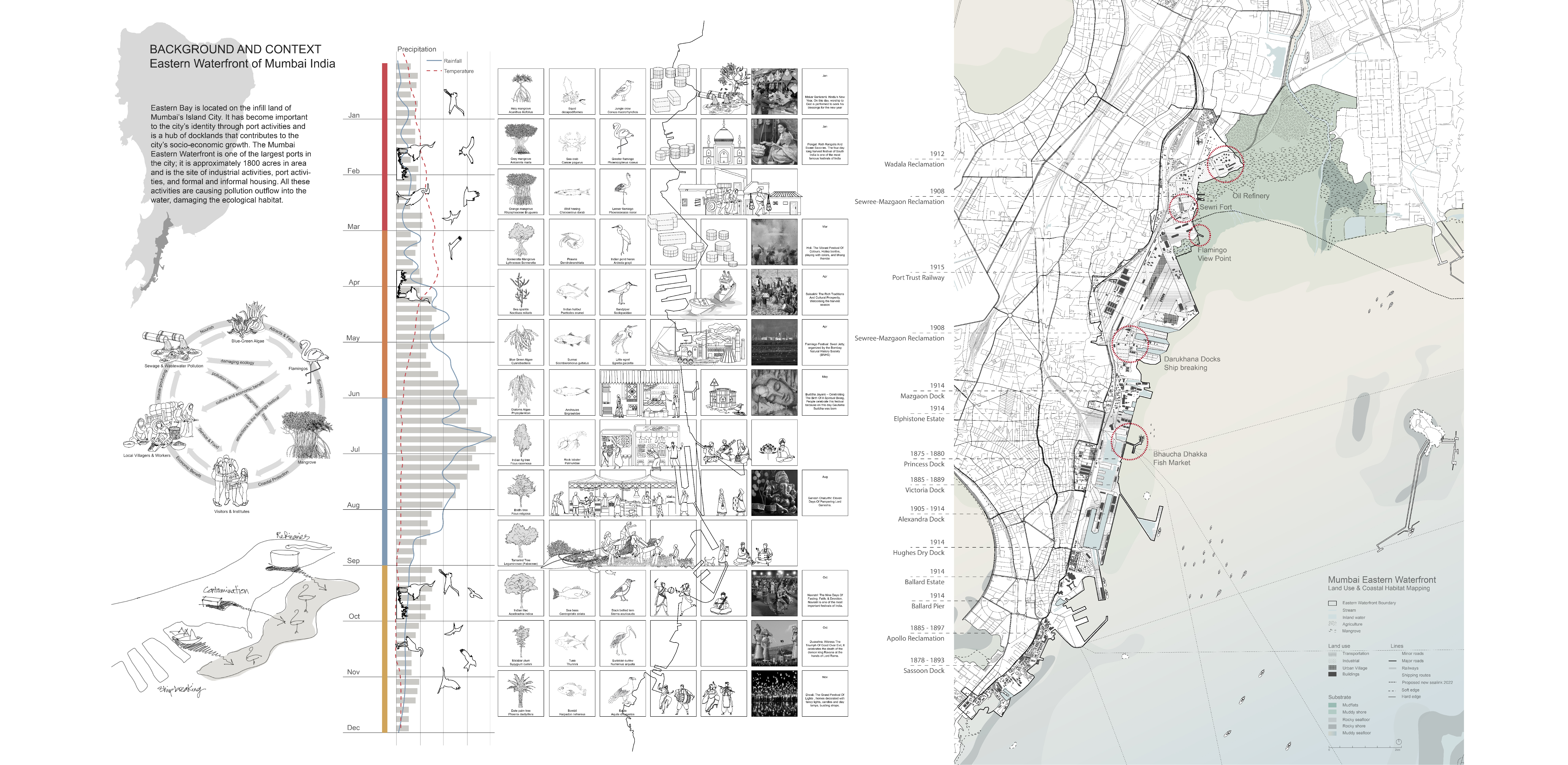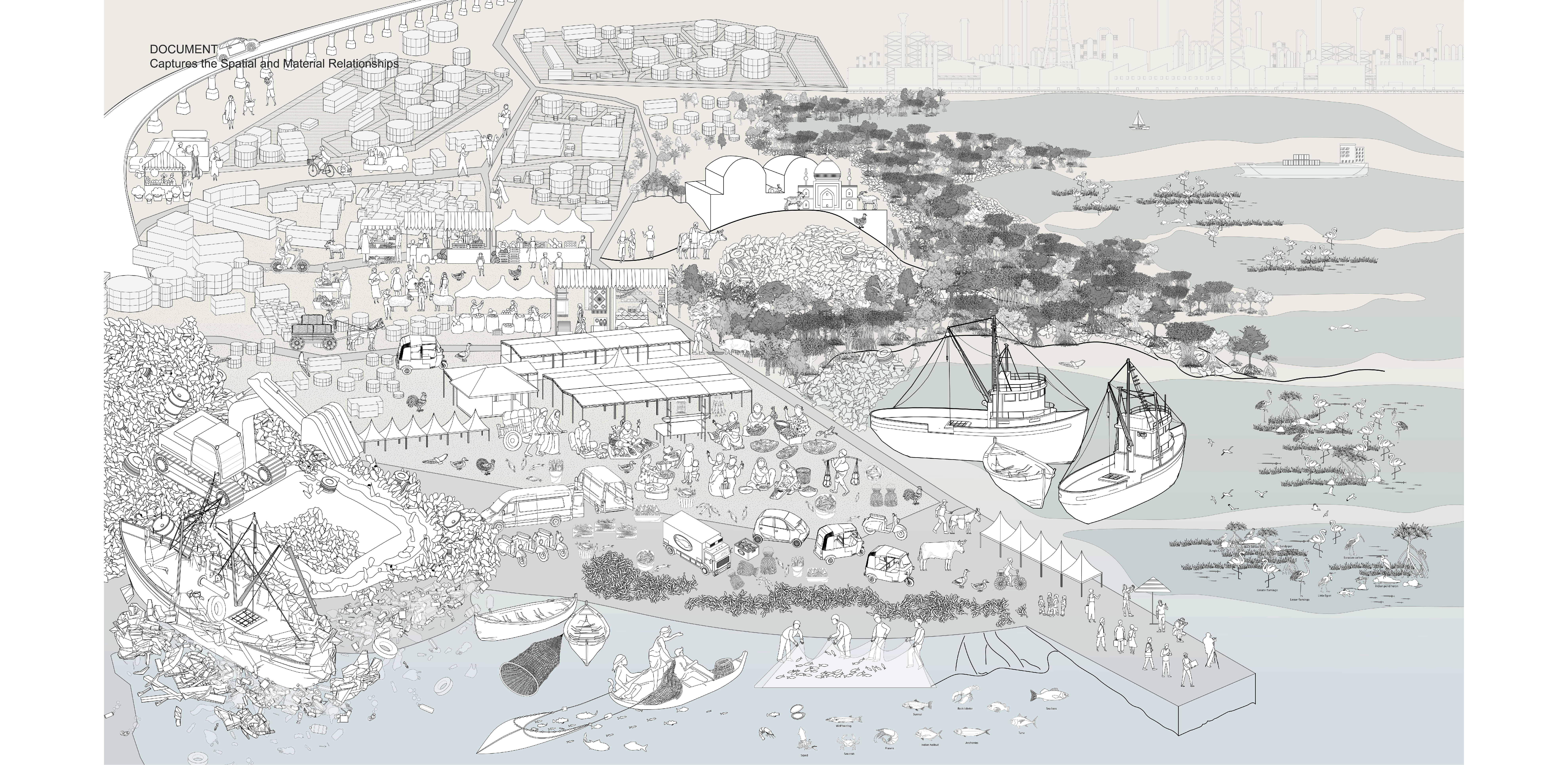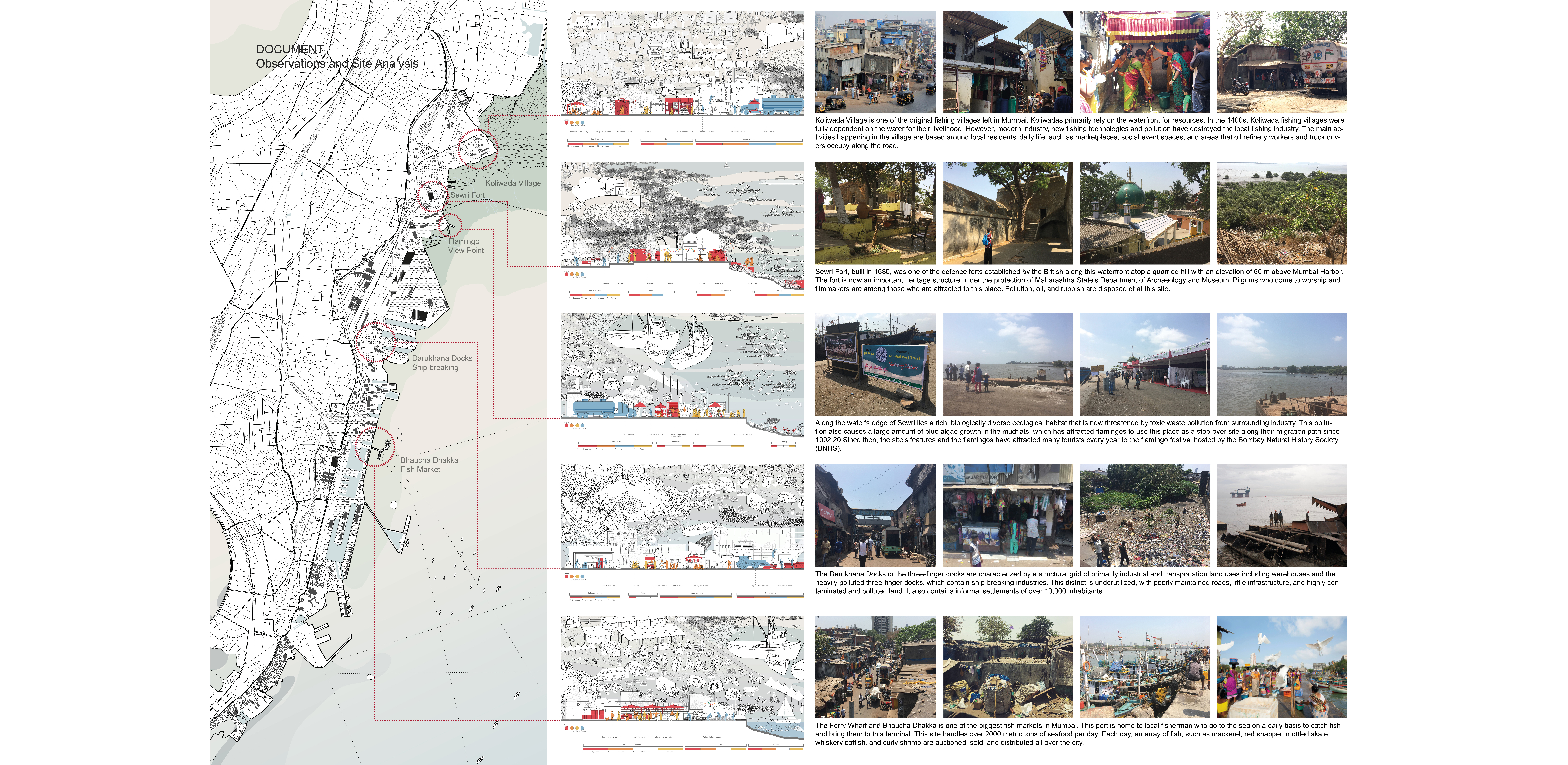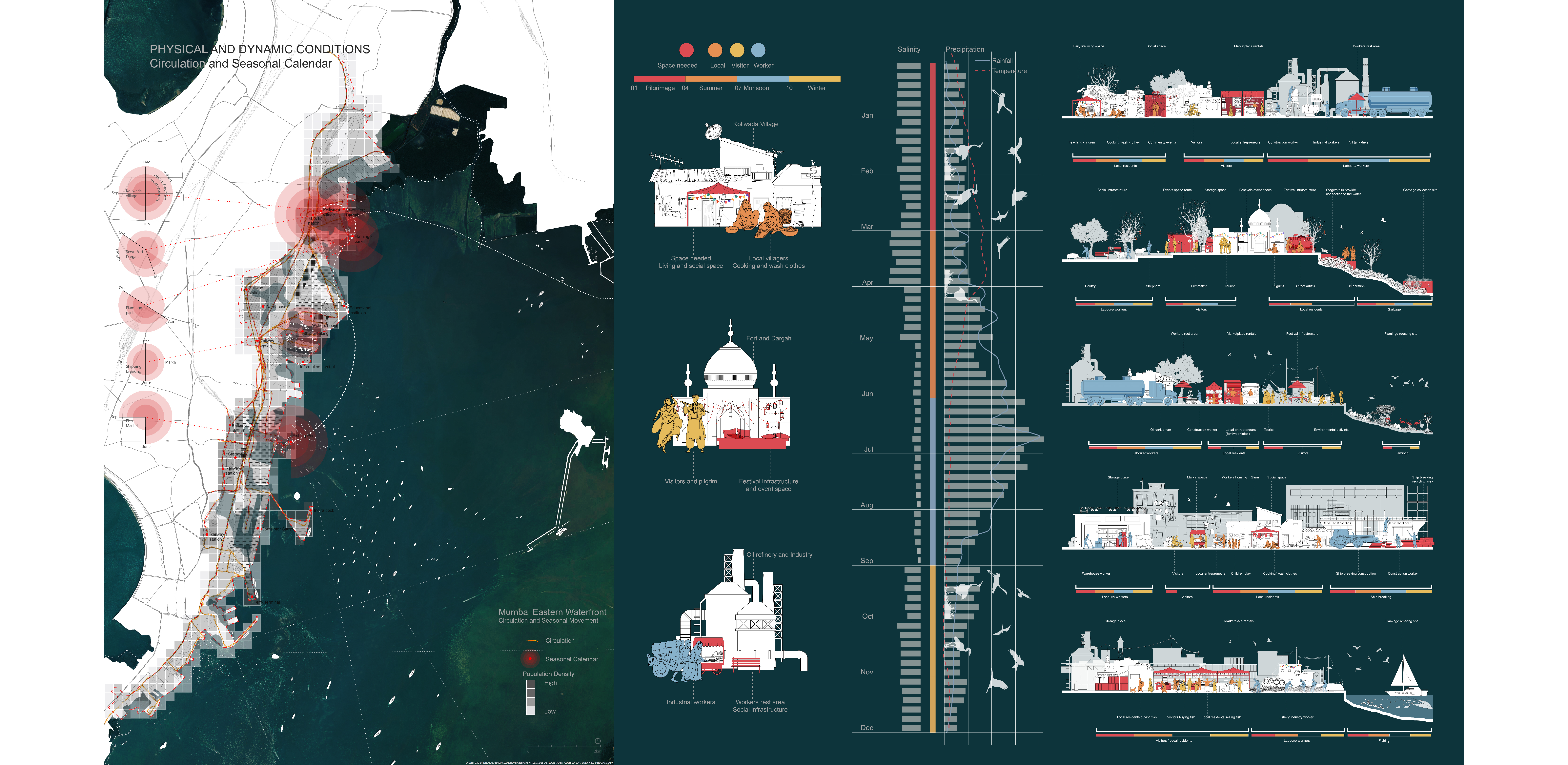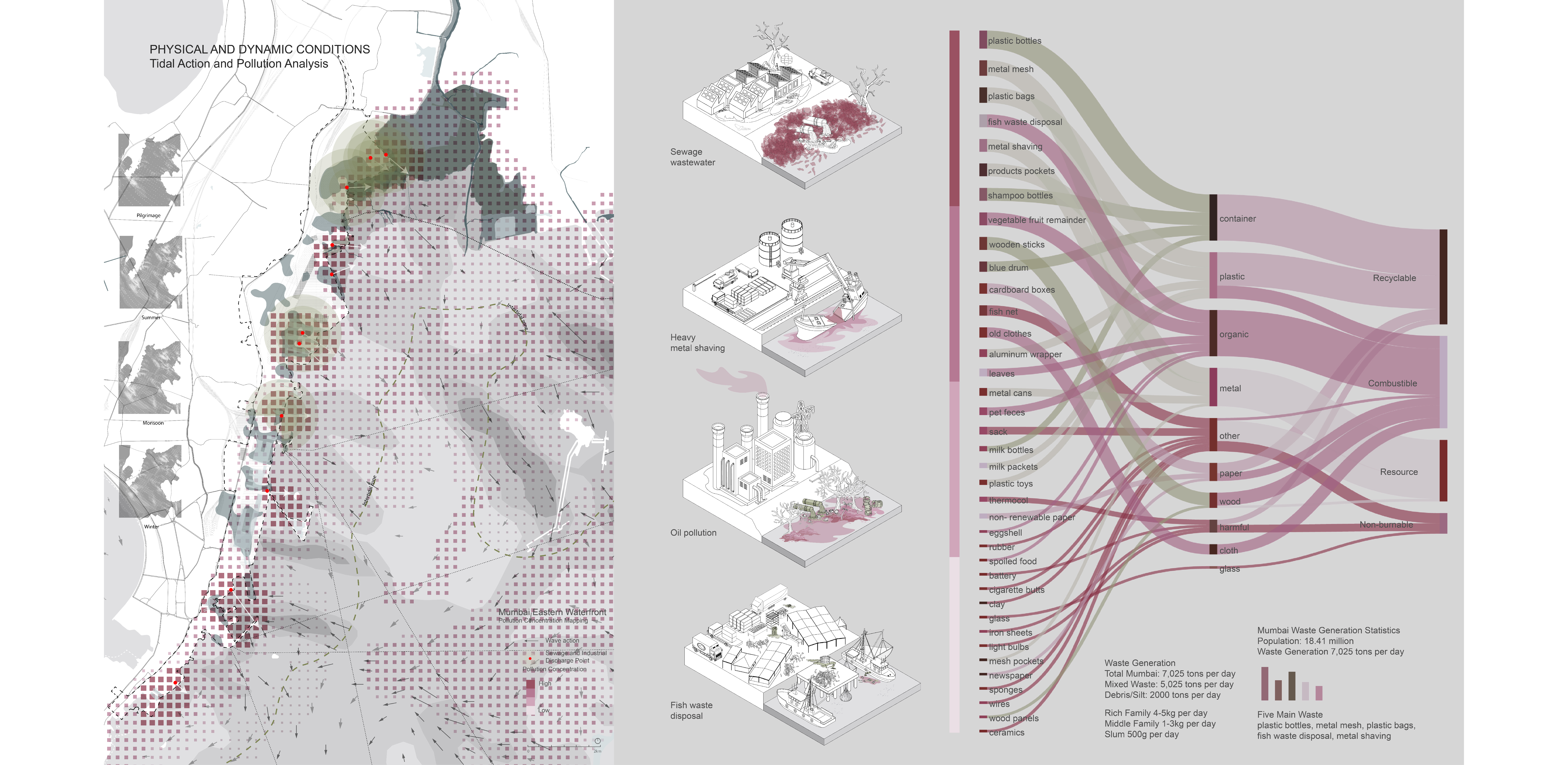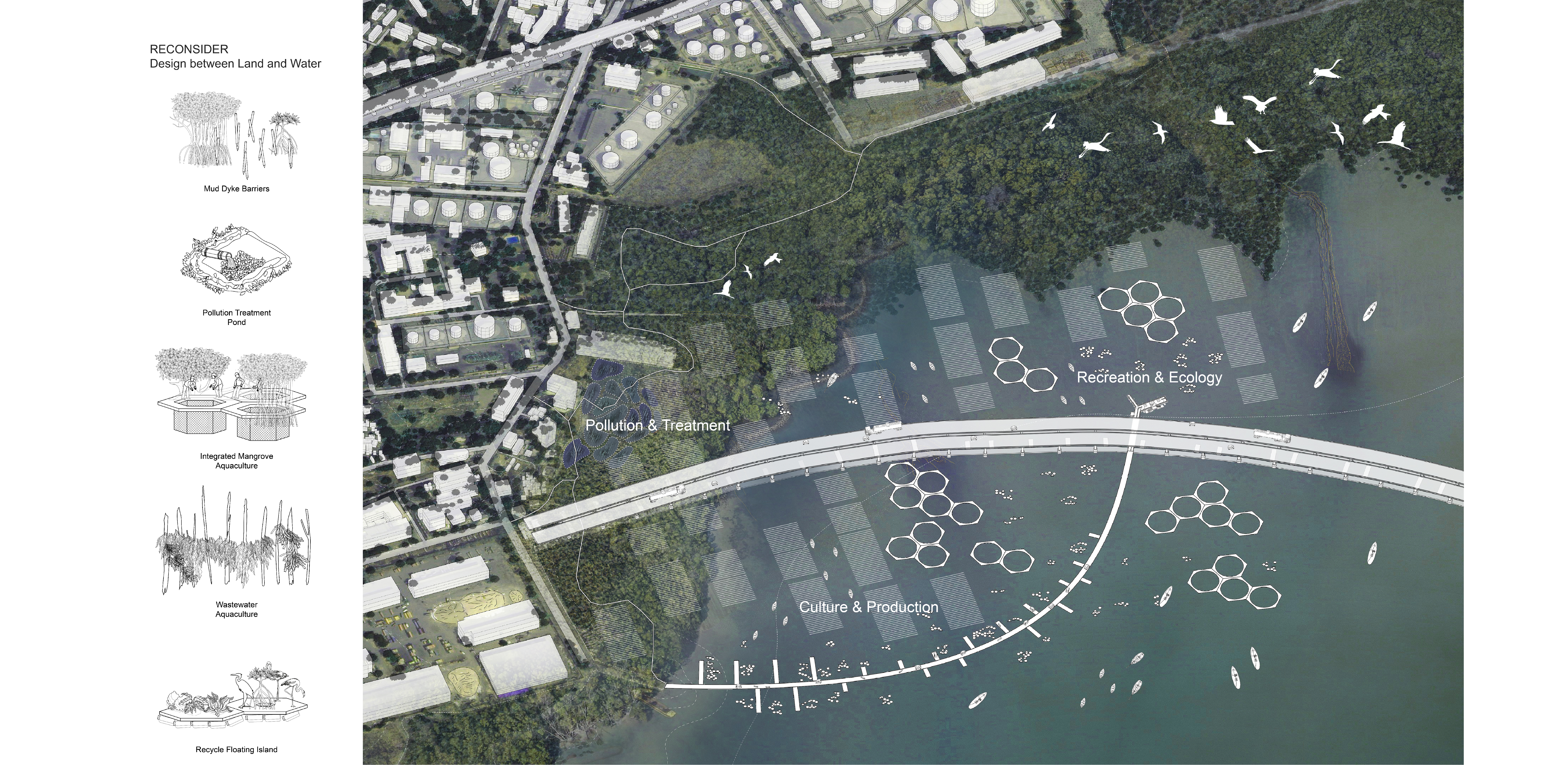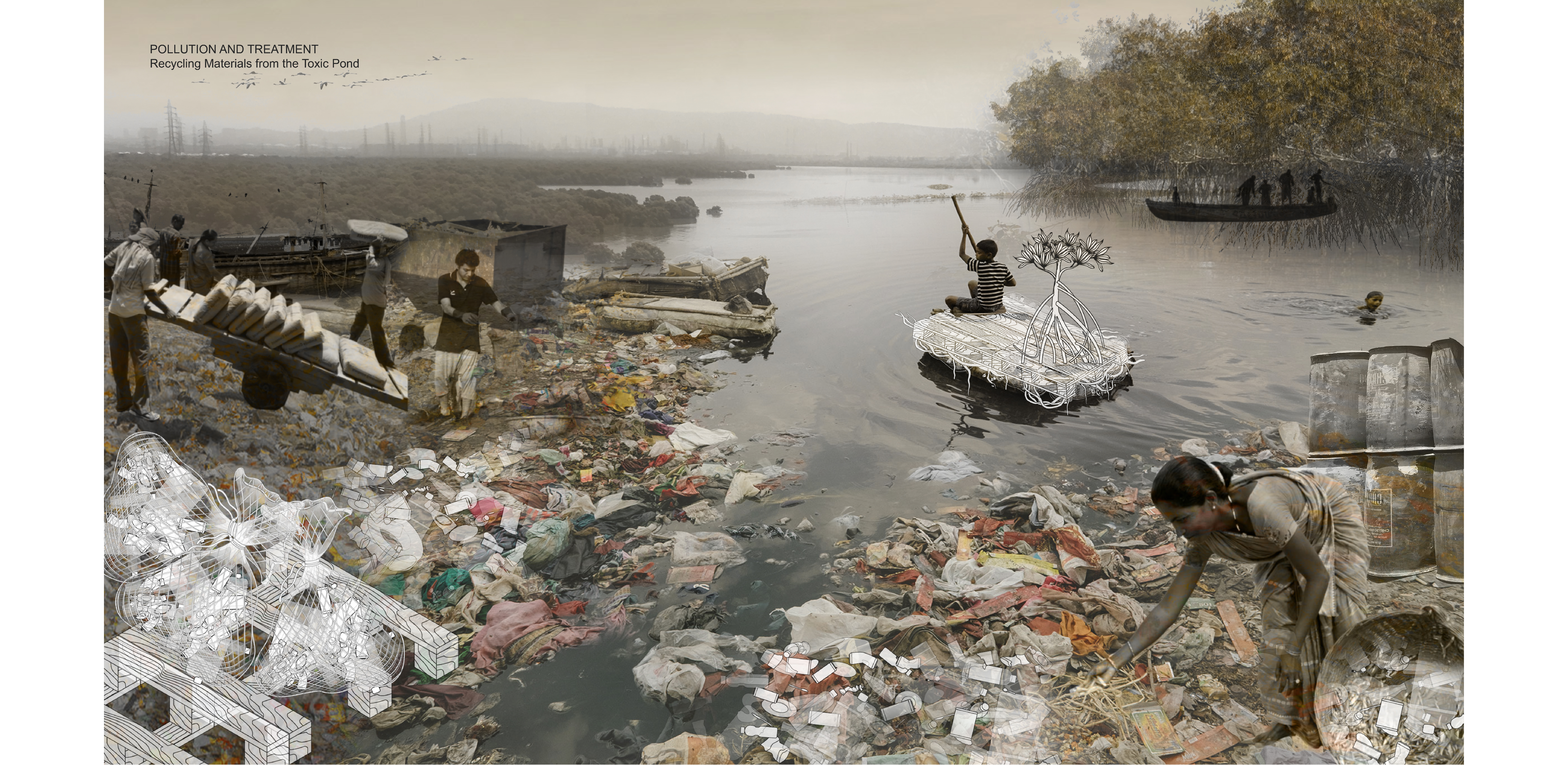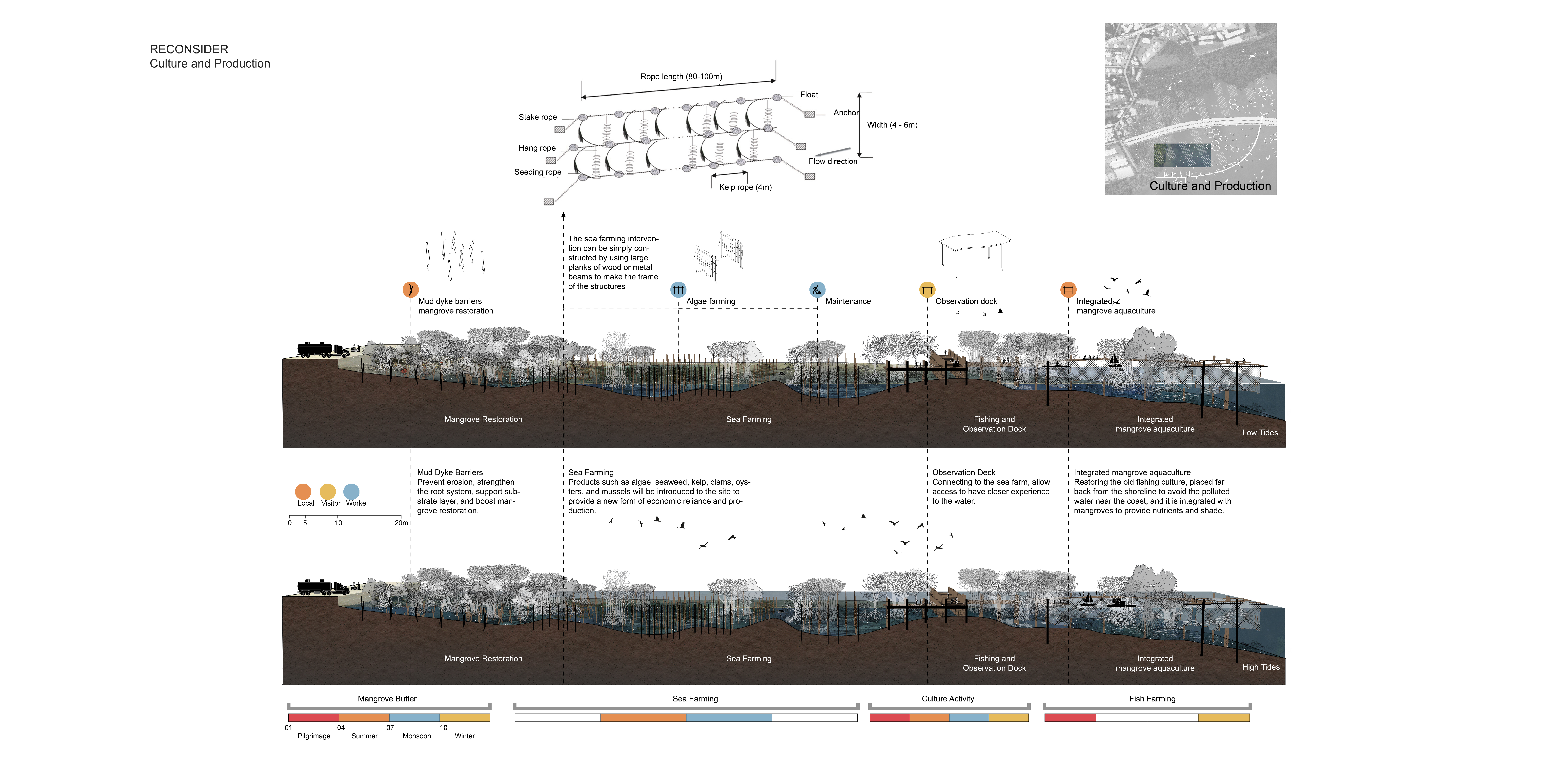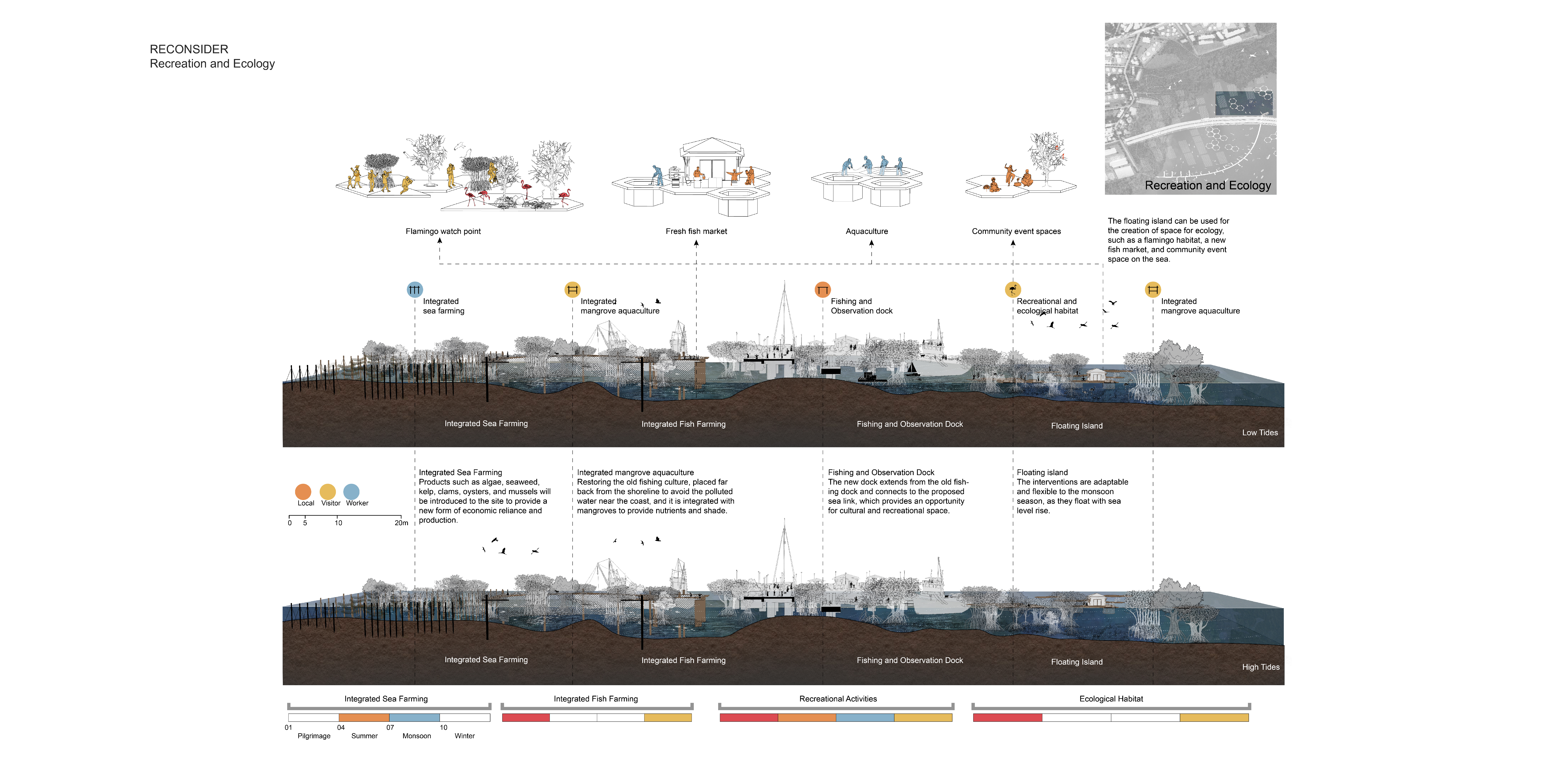Adaptive Traditions of the Eastern Waterfront of Mumbai, India
Honor Award
Urban Design
Zixin (Sing) Chen, Student ASLA
Faculty Advisors: Liat Margolis
University of Toronto, John H. Daniels Faculty of Architecture, Landscape, and Design
Mumbai’s eastern harbor is characterized by jarring juxtapositions of flamingo habitats and maritime wreckage, or historic fishing villages and petroleum plants. This proposal aims to harvest and repurpose buoyant waste materials into floating islands that would enable aquatic farming and become flamingo habitats, propelling newfound commitment to the waterfront. Industrial pollution causes blue algal blooms, upon which the flamingos feed, yet the pollution harms other marine growth. A design that recognizes the many local cultural conventions encourages new mangroves and pollution treatment ponds, which would serve multiple purposes, such as reducing toxins while promoting aquaculture that would continue to sustain nearby fisherfolk.
- 2020 Awards Jury
Project Statement
Rapid urbanization and population growth over the last century have resulted in many significant problems and challenges for the Eastern Waterfront of Mumbai. The rapid changes due to industry necessitate adaptive processes while still learning from generations of intimate knowledge with the sea. This project examines Mumbai’s Eastern Waterfront, which has a coexistence relationship with Koliwada village life, the area’s unique ecological habitat, and heavy industry. The project explores a unique form of documentation and captures the complex, dynamic, and intertwined spatial and material relationships of the site. It also recognizes the site’s cultural context and its people’s way of life by introducing a design movement that builds on indigenous and vernacular infrastructure to generate sustainable, resistant, and nature-based technology. The project aims to rethink and reconsider the land’s interface with the water, which plays an important role in the villagers’ livelihood and cultural and spiritual practices.
Project Narrative
Background and Context
The Mumbai Eastern Waterfront is one of the largest ports in the city; it is approximately 1800 acres in area and is the site of industrial activities, port activities, and formal and informal housing. All these activities are causing pollution outflow into the water, damaging the ecological habitat.
In symbiosis with these adverse social and environmental conditions are the hubs of life, activity, and creativity inside these informal settlements. There is a co-existence relationship between the village life along the waterfront, the ecological habitat, and heavy industry, and there is a very dense intermixing of these social and environmental dynamics.
Site and Observations
This project examines a particular way of documenting the complex dynamics and intermixing of the spatial and material relationships happening on the site, which have informed this drawing method that captures the area’s moments of life. This project focuses on revealing and analyzing the dynamics and diversity of current social, ecological, economic, and spatial relationships currently present in five contested areas within the Eastern Waterfront.
1. Koliwada Village
Koliwada Village is one of the original fishing villages left in Mumbai. Koliwadas primarily relies on the waterfront for resources. In the 1400s, Koliwada fishing villages were fully dependent on the water for their livelihood. However, modern industry, new fishing technologies and pollution have destroyed the local fishing industry.
2. Sewri Fort and Dargah
Sewri Fort, built in 1680, was one of the defence forts established by the British along this waterfront atop a quarried hill with an elevation of 60 m above Mumbai Harbor. Pollution, oil, and rubbish are disposed of at this site. This neglect stems from many forms of disconnection, as industrial pollution is trapped and concentrated within the mangrove roots, killing them and the surrounding ecosystems.
3. Flamingo watchpoint
The pollution from surrounding industry causes a large amount of blue algae growth in the mudflats, which has attracted flamingos to use this place as a stop-over site along their migration path since 1992. Since then, the site’s features and the flamingos have attracted many tourists every year to the flamingo festival hosted by the Bombay Natural History Society.
4. Shipbreaking yard
The Darukhana Docks or the three-finger docks are characterized by a structural grid of primarily industrial and transportation land uses including warehouses and the heavily polluted three-finger docks, which contain ship-breaking industries. This district is underutilized, with poorly maintained roads, little infrastructure, and highly contaminated and polluted land.
5. Fish Market
The Ferry Wharf and Bhaucha Dhakka is one of the biggest fish markets in Mumbai. This port is home to local fishermen who go to the sea on a daily basis to catch fish and bring them to this terminal. This site handles over 2000 metric tons of seafood per day.
Objectives and Approach
The project objectives and approach are to:
- Document: capture the complex, dynamic and intertwined spatial and material relationships of the site.
- Recognize: perceive the reality in a cultural context and demonstrate respect for a way of living.
- Reconsider: rethink the interface between the land and water, as the water plays an important role in people’s livelihoods and cultural/spiritual practices.
Intellectual Context
Julia Watson’s “Lo-TEK Design by Radical Indigenism” introduces the power of lo-tech, a design movement that builds on indigenous philosophy and vernacular infrastructure to generate sustainable, resilient, natural-based technology. For the Mumbai Eastern Waterfront, the idea of lo-tech design is appropriate to apply to the site because of the recognized reality in a cultural context, such as a lack of infrastructure and a lack of government support. By showing respect for a way of life, the lo-tech design allows local communities to better understand their needs and desires, thus not requiring the government to step in with planning policies and urban strategies. The lo-tech design provides a self-sustaining or self-constructed model that helps local residents have a better quality of life with respect to their culture and the environment they are living in, and provides a way to improve informal settlements and develop solutions that address current social and ecological challenges.
Physical and Dynamic Conditions
Activities and circulation are interrelated and connected, and the seasonal calendar is an important consideration when designing for the site. From April to June, the weather starts to get hotter and more humid. April is also the time when the tidal exchange changes. Large areas of mudflats and algae are exposed to the surface, which attracts flamingos to come to the site from October to April. This is when the flamingo festival is held, and it attracts visitors and commercial activities. July to September is the monsoon season, which receives the most rainfall in the year, and the tide rises 4 to 5 meters above sea level. The fish market has no activities during the monsoon season, as it is breeding time for fish and other sea creatures.
Lo-Tech Design Strategies
In response to the current issues, the design explores a series of lo-tech interventions used to rethink the shoreline through pollution and treatment, culture and production, and recreation and ecology. The first phase is to create a buffer along the shoreline by inserting a mud dyke barrier to prevent erosion as well as to restore the mangroves. The second phase involves providing wastewater treatment at the outflow area through aquaculture and algae farming while taking advantage of pollutants to introduce a new form of economic reliance and to use wastewater as a resource for aquaculture production. The integrated mangrove aquaculture provides opportunities to create a network of fish farms within the mangrove to provide nutrients for the fish and shelter for fishing. Further, a new place for gathering should be built by extending the existing dock, and a series of floating islands made of recycled materials that are adaptable and flexible to the monsoon season should be created.
Design Outcomes
1. Pollution and Treatment
This process provides a waste collection area and stops pollution from directly flowing into the sea, taking advantage of pollutants to maintain a dynamic balance that contributes to a functional landscape as well as provides access to the waterfront. Due to tidal changes during the monsoon season, the water level will rise by around 4–5 meters, which will bring the water into the treatment pond, allowing nutrients to feed the produce. The water level, however, will not reach the fertilization pond or the toxic pond.
2. Culture and Production
This process will allow sea farming materials to continue to filter nitrogen and carbon dioxide, restoring the old fishing culture, re-establishing the local community’s economic reliance, and extending the experience of the water further into the sea. This sea farming intervention can be simply constructed by using large planks of wood or metal beams to make the frame, and recycled plastic bottles will be used for the floating platform.
3. Recreation and Ecology
The new dock extends from the old fishing dock and connects to the proposed sea link, which provides an opportunity for cultural and recreational space. The floating island can be used for the creation of space, such as a flamingo habitat, a new fish market, and community event space on the sea. The interventions are adaptable and flexible to the monsoon season, as they float with sea-level rise.
Conclusion
This project explores a way to study a site through documenting, recognizing, reconsidering, and highlighting the adaptive process. It respects local cultures and ways of living while learning from generations of intimate knowledge of the sea. This design is not a master plan that instructs the locals on what is going to happen; instead, it demonstrates potential opportunities for the locals to improve their quality of life while respecting their culture.
